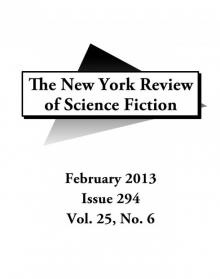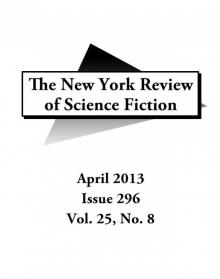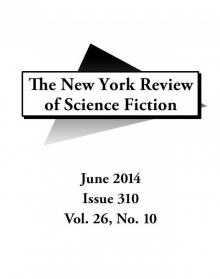- Home
- Kevin J Maroney
The New York Review of Science Fiction Issue #296 April 2013
The New York Review of Science Fiction Issue #296 April 2013 Read online
* * *
The New York Review of Science Fiction
ISSUE #296 April 2013 Volume 25, No. 8 ISSN #1052-9438
ESSAYS
Lomig Perrotin: I Will Whisper in the Dark
Brian Stableford: Notes on the Origins of the Term “Scientific Romance” and Its Implications for the Development of Science Fiction
Darrell Schweitzer: Rusty’s Space Ship Flies Again
Christopher S. Kovacs and Susan M. MacDonald: A Third Sampling of Medical Myths and Errors in Genre Fiction
Maarten Nellestijn: Doctor Atomic: Science Fiction Opera
Thomas A. Easton: The Prime Error
PLUS
More on possession in HPL, photos, and an editorial.
Samuel R. Delany, Contributing Editor; Kris Dikeman and Avram Grumer, Managing Editors.
Alex Donald, Webmaster; David G. Hartwell, Reviews and Features Editor; Kevin J. Maroney, Publisher.
Staff: Ann Crimmins, Jen Gunnels, Heather Masri, Lisa Padol, Christine Quinones, M’jit Raindancer-Stahl, Eugene Reynolds, Jason Strawsburg and Anne Zanoni.
Special thanks to Arthur D. Hlavaty and Eugene Surowitz.
Published monthly by Burrowing Wombat Press, 206 Valentine Street, Yonkers NY 10704-1814
Send all editorial inquiries and submissions to [email protected] and [email protected].
Individual issues and subscriptions are available worldwide in various electronic forms at Weightless Books and other fine establishments.
Paper copies of all issues are available individually or in bulk.
New York Review of Science Fiction Home Page: www.nyrsf.com
Copyright © 2013 Burrowing Wombat Press.
“All You Movers—” —please send us a working e-mail address and update your account, lest we lose you forever.
* * *
* * *
The New York Review of Science Fiction Readings
at the SoHo Gallery for Digital Art 18 Sullivan Street, just south of Houston
May 7th, 2013
Ron Hogan, Guest Curator
And then: Summer Break!
Watch this space for more details, or check out
Admission is a $5 donation. Doors open at 6:30, readings begin promptly at 7! All readings subject to change without notice.
To join the Readings mailing list please send a note to
* * *
I Will Whisper in the Dark
Lomig Perrotin
A photographic exploration of the world of H. P. Lovecraft
Howard Phillips Lovecraft is one of the fathers of modern fantasy literature, though he is better known for his contributions to horror. Born in 1890 in Providence, he died in poverty in 1938, never having known success in his lifetime. His work, which was the first to link scientific materialism and the supernatural, is characterized by the idea that behind the apparent banality of our existence lies a sickening and blasphemous truth. This truth cannot be revealed to the world, and Lovecraft himself shared it with us only in fragments to protect us from our own curiosity. There is resistance, opposition, even rebellion in the author’s inability to testify about the cosmic horrors that seem to watch humanity from beyond. To convey this resistance, I needed to explore the limits of the photographic medium. So I used cliché-verre, a technique of etching photographic material to create a mixed negative, blending the realistic aspect of photography with the graphic effects of drawing. Neither photographs alone nor illustration could reproduce this particular blend of horror and oneirism that characterizes the work of the master of Providence.
This work was displayed in November 2012 at Galerie 154: 154, rue Oberkampf, 75011, Paris.
—Lomig Perrotin, Les Lilas, France
I.
That place was very old, and the ceiling-high shelves full of rotting volumes reached back endlessly through windowless inner rooms and alcoves. There were, besides, great formless heaps of books on the floor and in crude bins; and it was in one of these heaps that I found the thing. I never learned its title, for the early pages were missing. . . .
—“The Book,” 1934
II.
Within twenty-four hours that machine near the table will generate waves acting on unrecognized sense organs that exist in us as atrophied or rudimentary vestiges. Those waves will open up to us many vistas unknown to man and several unknown to anything we consider organic life. We shall see that at which dogs howl in the dark, and that at which cats prick up their ears after midnight. We shall see these things, and other things which no breathing creature has yet seen. We shall overleap time, space, and dimensions, and without bodily motion peer to the bottom of creation.
—“From Beyond,” 1920
III.
Of all the distant objects on Federal Hill, a certain huge, dark church most fascinated Blake. It stood out with especial distinctness at certain hours of the day, and at sunset the great tower and tapering steeple loomed blackly against the flaming sky. . . .
The longer he watched, the more his imagination worked, till at length he began to fancy curious things. He believed that a vague, singular aura of desolation hovered over the place, so that even the pigeons and swallows shunned its smoky eaves.
—“The Haunter of the Dark,” 1935
IV.
When, after infinities of chaos, the first men came, the Great Old Ones spoke to the sensitive among them by moulding their dreams . . . Then . . . those first men formed the cult around small idols which the Great Ones showed them; idols brought in dim eras from dark stars. That cult would never die till the stars came right again, and the secret priests would take great Cthulhu from His tomb to revive His subjects and resume His rule of earth.
—“The Call of Cthulhu,” 1928
V.
Here, on a hellishly ancient table-land fully twenty thousand feet high, and in a climate deadly to habitation since a prehuman age not less than five hundred thousand years ago, there stretched nearly to the vision’s limit a tangle of orderly stone which only the desperation of mental self-defense could possibly attribute to any but conscious and artificial cause. . . . How could they be otherwise, when man himself could scarcely have been differentiated from the great apes at the time when this region succumbed to the present unbroken reign of glacial death?
—At the Mountains of Madness, 1931
VI.
The pit of the shoggoths! Down the six thousand steps . . . the abomination of abominations . . . I never would let her take me, and then I found myself there—Iä! Shub-Niggurath!—The shape rose up from the altar, and there were five hundred that howled. . . . I was there, where she promised she wouldn’t take me. . . . A minute before I was locked in the library, and then I was there where she had gone with my body—in the place of utter blasphemy, the unholy pit where the black realm begins and the watcher guards the gate. . . .
—“The Thing on the Doorstep,” 1923
VII.
At times he actually did perform marvels of surgery for the soldiers; but his chief delights were of a less public and philanthropic kind, requiring many explanations of sounds which seemed peculiar even amidst that babel of the damned. Among these sounds were frequent revolver-shots—surely not uncommon on a battlefield, but distinctly uncommon in an hospital. Dr. West’s reanimated specimens were not meant for long existence or a large audience.
—“Herbert West, Reanimator,” 1921–22
VIII.
I am Basil Elton, keeper of the North Point light that my father and grandfather kept before me. Far from the shore stands the
grey lighthouse, above sunken slimy rocks. . . . Past that beacon for a century have swept the majestic barques of the seven seas. In the days of my grandfather there were many; in the days of my father not so many; and now there are so few that I sometimes feel strangely alone, as though I were the last man on our planet.
—“The White Ship” (1919)
IX.
He knew his room was in the old Witch House. . . . A room was easy to secure; for the house was unpopular, hard to rent, and long given over to cheap lodgings. Gilman could not have told what he expected to find there, but he knew he wanted to be in the building where some circumstance had . . . given a mediocre old woman of the seventeenth century an insight into mathematical depths perhaps beyond the utmost modern delvings of Planck, Heisenberg, Einstein, and de Sitter.
—“The Dream in the Witch-House” (1932)
X.
It was the coroner, seated near a window overlooking the yard, who first noticed the glow about the well. . . . It had a very queer colour, and as all the men clustered round the window Ammi gave a violent start. For this strange beam of ghastly miasma was to him of no unfamiliar hue. He had seen that colour before, and feared to think what it might mean. He had seen it in the nasty brittle globule in that aerolite two summers ago, had seen it in the crazy vegetation of the springtime, and had thought he had seen it for an instant that very morning against the small barred window of that terrible attic room where nameless things had happened.
—“The Color out of Space,” 1927
XI.
At certain stages of the ritual they did grovelling obeisance, especially when he held above his head that abhorrent Necronomicon he had taken with him; and I shared all the obeisances because I had been summoned to this festival by the writings of my forefathers. Then the old man made a signal to the half-seen flute-player in the darkness, which player thereupon changed its feeble drone to a scarce louder drone in another key; precipitating as it did so a horror unthinkable and unexpected.
—“The Festival,” 1923
XII.
I am forced into speech because men of science have refused to follow my advice without knowing why. . . .
Doubt of the real facts, as I must reveal them, is inevitable; yet, if I suppressed what will seem extravagant and incredible, there would be nothing left. The hitherto withheld photographs, both ordinary and aerial, will count in my favor, for they are damnably vivid and graphic. Still, they will be doubted because of the great lengths to which clever fakery can be carried.
—At the Mountains of Madness, 1931
* * *
Notes on the Origins of the Term “Scientific Romance” and Its Implications for the Development of Science Fiction
Brian Stableford
It is impossible to determine with any certainty who coined the term “scientific romance” or when it was first used in print. The earliest use of the phrase that it was possible to find in December 2012 by searching for it among the digital documents indexed by the Hathi Trust and Google Books is in a footnote to a dissertation on Saxon law by the barrister James Ibbetson, first published in 1780. In that essay, Ibbetson refers scathingly to a suggestion that a medieval Saxon legal custom might have originated in Troy, and the corollary account of its importation to Britain, as “the dreams of prejudice and scientific romance” (36).
The idea that refugees from Troy, led by one Brutus, credited by legend as Britain’s first lawgiver, had once settled in Britain was already ancient in 1780. It had been credited by scholars to Celtic legends allegedly preserved in Welsh chronicles and had become sufficiently familiar for many English writers, including Edmund Spenser and John Milton, to allude to it, but it is certainly fanciful. Indeed, the entire legendary “history” of Britain prior to the reign of King Alfred is a vast tissue of fantasies, much of it invented by the Normans in the wake of the eleventh century “conquest” in the spirit of “romance,” and it was subsequently subjected to a continual process of remolding as litterateurs and scholars attempted to reconcile Norman fancy with previous Saxon and Celtic fancy.
In all probability, James Ibbetson, as a man of law, meant to imply little more by his scathing dismissal of the Trojan origins of British law than the mere fact that it was nonsense—but given that, the fact that he chose not merely the term “romance,” but the term “scientific romance,” is revealing. If we are to understand why that particular portmanteau term came into existence in the latter half of the eighteenth century, it might be helpful to examine briefly the contemporary implications of both of its components more closely.
The English word “romance” comes from a group of French words, including both roman and romance, derived from the Old French romanz, whose approximate meaning was “vernacular” and which was usually used to refer to documents translated from Latin. “Romance” was imported to the English language by the Normans after the conquest, but its French equivalents were in the midst of a striking evolution by then. They were used in a general sense with reference to “romance languages” descended from Latin. But in the eleventh century, they were more frequently and more particularly used with reference to a genre of poetry and prose fiction that had begun with translations of Latin epic poetry but had soon given birth to prolific original composition. Just as the translations had referred to what was by then a distant mythologized past, the imitations and pastiches also looked back nostalgically to a whole series of mythologized distant pasts.
By the middle of the twelfth century—the heyday of the conquering Normans, who had originated as invaders from Scandinavia—such works had become enormously popular. They had become a kind of ideological enshrinement of the feudal political system, glorifying the contemporary hierarchy of kings, barons, and knights by extending it backwards into imaginary pasts and crediting it with imaginary virtues. In the late Middle Ages, the rulers of both France and England had long been descended from northern invaders—the Franks and the Saxons—who had partly displaced and partly absorbed previous cultures, loosely describable as Gauls and Celts. Both had been previously conquered by the Romans, so the mythological pasts cooked up in France and England in the twelfth century were blessed with a rich complexity and confusion of inherited and improvised materials.
Literary “Romance” was, in consequence, an inherently syncretic genre, tacitly celebrating the kind of unification obtained by conquest and reorganization that was characteristic of the actual history of feudalism as well as the flattering ideological image that romancers tried to construct. Although the “chivalric romance” glorifying knightly prowess in combat was at its heart, it also embraced “courtly romance,” which offered an idealized depiction of intimate relationships, and it was enthusiastic to embrace all kinds of local superstitions and gather them into a generalized melting-pot—always, of course, with the proviso that any threats originating from such dubious folk apparatus could not withstand the ideological forces of Christian faith and knightly heroism.
In France, where political domination was shared by two sets of northern invaders whose mastery was by no means total or wholly secure, the key imagery of chivalric and courtly romance was nostalgically attached to and partly derived from cultures with a longer local history. The courtly apparatus was associated with the southern region of Provence, whose Roman roots had been conflated with Arabic influences imported via Moorish Spain, and the chivalric apparatus had a particular link with the western region of Brittany, the population of which had strong ethnic links with those of Cornwall and Wales. When the Normans imported Romance into England, therefore, it was only natural that the romances relating to the island should concoct an imaginary history that was distinctly affiliated to the Breton chivalric strand of French romance with a relatively light seasoning of courtly romance. The imaginary history in question focused primarily on legends of King Arthur, the Knights of the Round Table, and the wizard Merlin, to which was added—by courtesy of an unfinished allegory penned by Chrétien de Troyes—the striking
original element of the quest for the Holy Grail. The tale of Brutus and his earlier refugees from Troy became a minor element in that vast tissue of invention.
The entire substance of medieval romance is deliberately fanciful. It is an extravagant, fantastic, magnificent, and beautiful tissue of blatant lies. Like all fiction, however, it relied to some extent for its rhetorical effect on the assertion of its truth, and the more blatant its lies were, the harder it had to emphasize its pretense: a necessary paradox. It would probably be unsafe to say that composers of romances were never fooled by their own inventions because charlatans are notoriously liable to fall prey to their own patter, but in the main, the inventors of romances cannot have been unaware that they were weaving pure fantasies, even though they were obliged to assert the opposite in order to pay due court to their readers’ “willing suspension of disbelief.”
The vast majority of hearers and readers of medieval romances cannot have been fooled by that imposture any more than modern children can really believe in Santa Claus, but in the same spirit of preserving rhetorical effect, they might well have pretended to believe, at least temporarily. Subsequent scholars, however, were sometimes much less certain of the total falsehood of romance, having an innate tendency of their own to suspect and to judge that, even if it were not literally or entirely true, something in writing must surely have a seed of reliability within it. Indeed, one of the primary activities of scholarship throughout the ages, if not the primary activity, has been the sustained and determined endeavor to prove the false true, especially if it has been written down.

 NYRSF February 2013 Issue 294
NYRSF February 2013 Issue 294 The New York Review of Science Fiction Issue #296 April 2013
The New York Review of Science Fiction Issue #296 April 2013 The New York Review of Science Fiction Issue 310, June, 2014
The New York Review of Science Fiction Issue 310, June, 2014